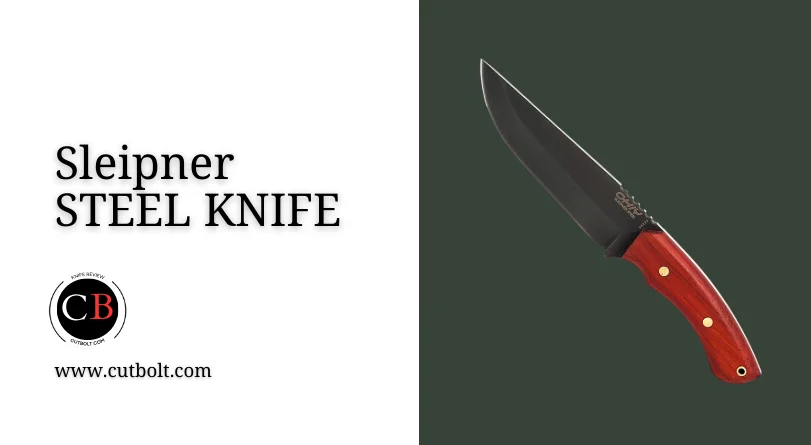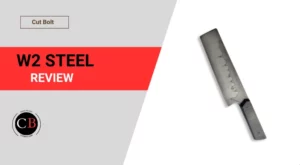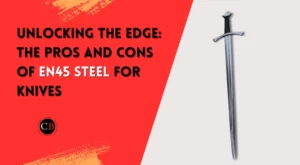I recently came across this knife from LION STEEL, the name is interesting, but I saw it for the first time. The name of the steel is SLEIPNER. The knife is good, but what’s the deal with the steel?
Is Uddeholm Sleipner steel good for knives? I have answered some questions, such as Uddeholm Sleipner – what kind of steel is it? How hard is it, what is its chemical composition, and so on.
If you are also interested in the answers to these questions, then look no further. Just stay tuned, read on and find out if Uddeholm Sleipner is good steel for knives.
Table of Contents
What is Uddeholm Sleipner?
Uddeholm Sleipner is a new generation D2 tool steel with improved hardness, toughness and strength of the cutting edge from the manufacturer Uddeholm. Sleipner steel is used for the production of knives and tools. In some articles it is referred to as stainless steel – which it is not, we will see why later.

Chemical composition of Uddeholm Sleipner steel
| Element | Portion | Effect |
| Chromium | 7.8% | Improves wear resistance, heat resistance and scale resistance. It increases tensile strength because it acts as a carbide former. Use of rust-proof or stainless steel, as it increases corrosion resistance from a mass proportion of 12.2%. Reduction in weldability. |
| Carbon | 0.7% | Increasing hardness and tensile strength. In larger quantities, increase in brittleness and a reduction in forgeability and weldability. |
| Manganese | 0.5% | Improves hardness and tensile strength. |
| Molybdenum | 2.5% | Improves hardenability, tensile strength and weldability. Reduction in forgeability and ductility. |
| Silicon | 0.9% | Improves strength. |
| Vanadium | 0.5% | Increasing hardness, increasing wear resistance and improving tempering resistance. |
Uddeholm Sleipner consists of carbon, chromium, molybdenum, manganese, silicon and vanadium with a chromium content that is too low to make it a rustproof steel. For that, it would have to contain more than 13% chromium. Sleipner is therefore a tool steel.
What is the hardness (HRC) of Uddeholm Sleipner?
On the Rockwell C hardness scale, Sleipner steel has a value between 58 and 64 HRC. However, the exact value depends on the type of heat treatment used by the manufacturer.

The maximum hardness value of 64 HRC is quite high, although not the highest (ZDP-189, for example, is even harder). The high hardness is due to the high carbon content and the presence of vanadium and manganese.
Is Uddeholm Sleipner stainless steel?
Uddeholm Sleipner is not rust-free steel but stainless steel. To be considered stainless steel, a steel may only contain a maximum of 0.025% of sulfur and/or phosphorus (so-called iron companions) (stainless steel composition). In Uddeholm Sleipner steel, there is practically no sulfur or phosphorus, so it can call itself stainless steel without any doubt.
To be considered rustproof, it must have a chromium content of at least 10.5 – 13% dissolved in austenite or ferrite, depending on the definition. With about 7.8%, the chromium content in Uddeholm Sleipner Steel is unfortunately not sufficiently represented to be able to classify it as rust-free. But it is a stainless steel.
Properties of Sleipner steel
According to the chemical composition and hardness of Uddeholm Sleipner, it offers the following properties and characteristics:
Edge retention
With a maximum hardness of 64 HRC, Sleipner offers good edge retention. Its cutting edge can be made very sharp and this can then maintain the sharpness for a satisfactorily long period. However, it would be unrealistic to expect the edge retention of a premium steel.
Corrosion resistance
The corrosion resistance of Uddeholm Sleipner is quite good with a chromium content of 7.8%, but not so good as to require no maintenance at all.
Since Sleipner steel is not rust-free, it cannot be expected to have good corrosion resistance. However, with 7.8% chromium and 0.9% silicon, this steel offers average corrosion resistance.
Because of the low chromium content, it is advisable to give a Sleipner blade regular care to avoid surface corrosion. As a rule, cleaning and oiling after use is sufficient. To further increase corrosion resistance and thus expand the range of use, the manufacturer LionSteel offers its Sleipner knives with an anti-corrosion coating.
Wear resistance
Generally speaking, the harder a knife steel is, the more wear-resistant it is. Considering that the hardness level of well-hardened Sleipner steel is above average, we can conclude that it also has good wear resistance. We can say this is because of the combination of carbon and molybdenum. This mixture also makes this steel tough enough to withstand impacts.
Sharpening
The rule is that the harder the steel, the harder it is to sharpen. Sleipner is a hard steel and it is not easy to sharpen.
This is also true for knives made of Sleipner steel. Since its hardness level can reach up to 64 HRC, it is definitely not an easy-to-sharpen knife blade. Sharpening requires time and effort and possibly appropriate tools to get it appropriately sharp.
Machinability
Uddeholm Sleipner grinds well and is otherwise easy to machine.
Toughness
You would think that Uddeholm Sleipner steel would not be that tough, as it is very hard. After all, higher hardness in steels means lower toughness, right? Sleipner is surprisingly tough enough not to chip. After all, one of the goals of Sleipner steel was to be a modern version of classic D2 tool steel with better toughness and thus a higher-quality option.

Is Uddeholm Sleipner a good knife steel?
Yes, Sleipner is an excellent knife steel – it offers great robustness and hardness combined with good corrosion resistance. It would be a great choice for a survival knife, hunting knife, camping knife or even an EDC knife. But don’t forget: Sleipner is not completely rustproof but only “low rust”, so it should also undergo some maintenance (dry and oil after use). As for the cutting edge: although the edge retention is quite good, do not expect the edge retention of a premium steel – new generation steel does not equal premium steel.
Comparison of Sleipner steel with other knife steels
Uddeholm Sleipner vs D2 steel
As mentioned earlier, Uddeholm Sleipner is an improved version of D2. Both differ in their chemical composition, although they are semi-stainless steel (“semi-inox”).
D2 contains more carbon and chromium and is therefore theoretically harder than Sleipner. This also means that D2 has an advantage in terms of wear. However, this makes D2 more difficult to sharpen. A Sleipner blade can achieve even better sharpness due to the finer grain structure of the steel. Sleipner is also tougher than D2. In terms of edge retention, Sleipner is a close competitor.
Although corrosion resistance is virtually identical, Sleipner’s corrosion resistance in humid environments and seawater is probably better than D2’s. However, to some extent, it is pure theory and depends on various influencing factors.
Uddeholm Sleipner vs A2 steel
Sleipner steel is more wear-resistant than A2, although the latter has an even slightly higher maximum hardness. Sleipner is also tougher than A2, although only slightly.
Uddeholm Sleipner steel equivalents
Some people think that Sleipner comes very close to M390. I would like to disagree and say, no, it does not. M390 is on a slightly higher level compared to Sleipner. I would put Sleipner between A2 and D2 – D2 is better in terms of corrosion resistance and A2 is slightly better in terms of hardness.
Conclusion: Uddeholm Sleipner steel review
We have reached the end of this article. To briefly summarize: Uddeholm Sleipner is definitely not a bad choice for knives, but it is not the perfect steel either.
It is better suited for tough applications and demanding tasks in adverse conditions. It can also be used in wet environments without rusting immediately (but still needs some care as it is not stainless).
On the other hand, it does not reach the balance of premium steels like M390 or ZDP-189, but I will say it can be considered the best of the mid-range entry-level steels.
Finally, it should be noted that “new generation” steel is not synonymous with “premium” steel.



